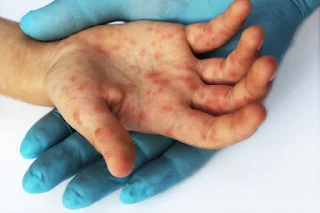Hand, Foot and Mouth Disease
Introduction
Hand, foot and mouth disease is a highly contagious enteroviral infection (usually caused by Coxsackie virus A16 or enterovirus 71), primarily affecting infants and children <10 years old.
- It spreads from person to person by coughing or sneezing, or by contact with mucus, saliva, blisters or the poo of an infected person. Children can also easily catch the disease by touching contaminated things (e.g. toys) and then putting their hands or toys in their mouth.
- Infected persons are most contagious during the first week of illness, but virus may be transmissible for weeks after symptoms have resolved (active virus may be shed in stool for up to 4-8 weeks).
Symptoms
Patients usually present with a maculopapular/vesicular rash on the extremities (predominantly the hands and to a lesser extent the feet) and painful oral lesions, which is often preceded by a 12-36 hour prodrome that may include fever (first sign), sore throat, tiredness and loss of appetite.
Conversely, the clinical presentation of these same viral illnesses may be limited to fever and painful oral lesions, in which case it is clinically referred to as herpangina.
Management
No effective antiviral therapy is available and the illness typically resolves spontaneously within 5-10 days. Frequent handwashing and avoiding close contact with infected person may help reduce risk of infection.
Supportive treatment may be used to alleviate symptoms.
- Hydration by drinking enough liquids or IV fluids in patients with dehydration and/or are unable to swallow liquids.
- OTC medications to reduce fever, pain, and inflammation
- e.g. paracetamol and ibuprofen
Children should be kept home if they are unwell or have blisters. They should not return to school or childcare until all of the blisters have dried.
Indications for Hospitalization
A failure to maintain adequate hydration.
Development of neurologic or cardiopulmonary complications (rare), such as
- Encephalitis
- Meningitis
- Flaccid paralysis
- Myocarditis
External Links
- MOH HFMD Guidelines, 2007
- MyHEALTH - HFMD
- DynaMed - Hand-foot-and-mouth Disease
- KidsHealth - Hand, Foot & Mouth Disease
- CDC - HFMD Symptoms and Complications
- Mayo Clinic - Hand-foot-and-mouth disease
- Hand-Foot-and-Mouth Disease: Rapid Evidence Review, 2019
- FDA takes action against the use of OTC benzocaine teething products due to serious safety risk, lack of benefit, 2018

Comments
Post a Comment